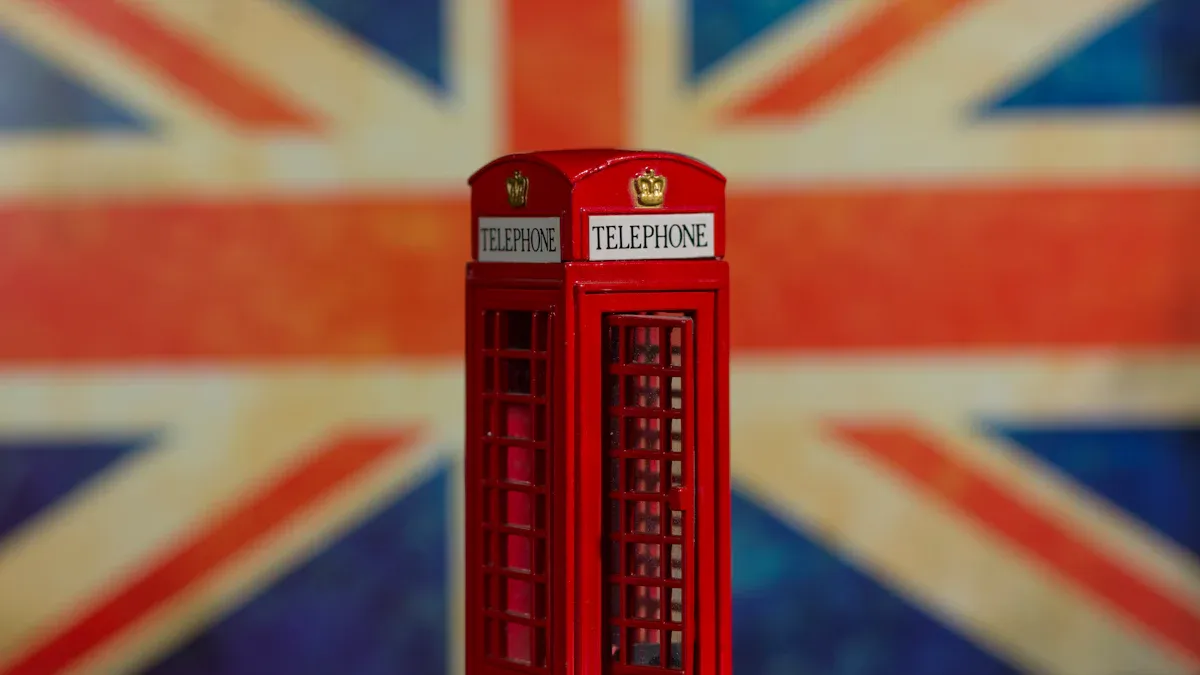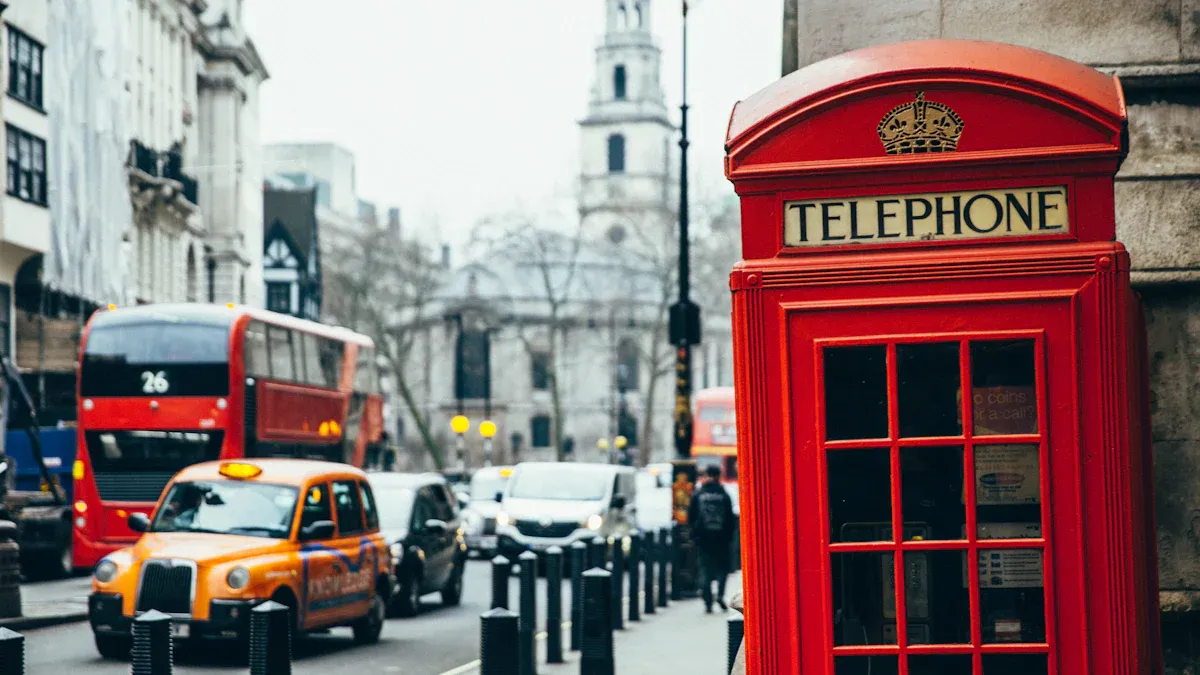- EasyCard
- Trade
- Help
- Announcement
- Academy
- SWIFT Code
- Iban Number
- Referral
- Customer Service
- Blog
- Creator
What is the Telephone Code of the United Kingdom? Basic Rules for Making Calls to the UK

Image Source: pexels
The UK phone code is +44. When calling the UK from mainland China or any other country/region, mastering one core rule is crucial.
You must replace the extra “0” at the beginning of the UK phone number with the country code +44.
This simple operation is the key to ensuring a successful call. Through the following step-by-step guide and clear examples, you will find that correctly dialing UK numbers is actually very simple, allowing you to easily connect with your family, friends, or colleagues in the UK.
Core Points
- The UK’s country code is +44.
- When calling the UK from abroad, the leading “0” in the UK number must be removed.
- UK phone numbers typically consist of the country code, area code, and local number.
- When making calls within the UK, the full number, including the area code, is usually required.
- Before calling the UK, be sure to consider the time difference and note that some numbers may incur high charges.
UK Phone Code and Number Structure Breakdown

Image Source: pexels
To fully master the dialing method, you first need to understand the composition of UK phone numbers. A complete UK number typically consists of three parts: country code, area code, and local number. Let’s break them down one by one.
Country Code: +44
+44 is the exclusive code assigned to the UK by the International Telecommunication Union (ITU). When calling from any country or region outside the UK, this code tells the global telephone network that you want to connect the call to the UK.
Did you know? The story behind the +44 code The assignment of international phone codes is not random.
- The International Telecommunication Union (ITU) established the modern telephone numbering system in the 1960s, dividing the world into nine zones.
- Europe, with its many countries, was assigned zone codes “3” and “4”.
- Major countries like the UK and France received shorter, more memorable country codes.
- In addition to the UK mainland (England, Scotland, Wales, and Northern Ireland), the +44 UK phone code also covers Crown dependencies such as Guernsey, Jersey, and the Isle of Man.
Area Code and Trunk Code “0”
In the UK, you will see that landline numbers usually start with a “0”. This “0” is not part of the area code but is the UK’s domestic trunk code. Its purpose is used when making calls to different regions within the UK.
The length of UK area codes is not fixed, usually ranging from 2 to 5 digits. Large cities have shorter area codes, while smaller towns have longer ones.
| City | Dialing Format Within the UK (with “0”) | Actual Area Code (after removing “0”) |
|---|---|---|
| London | 020 | 20 |
| Birmingham | 0121 | 121 |
| Manchester | 0161 | 161 |
| Edinburgh | 0131 | 131 |
| Glasgow | 0141 | 141 |
Core Rule: When calling from abroad, you must remove this trunk code “0” and use +44 followed directly by the area code.
Local Number
The local number follows the area code and is the unique number assigned to a specific household or business. Its length is typically 6 to 8 digits, depending on the region.
A complete UK landline number (including the leading “0”, area code, and local number) is usually 11 digits in total. For example, the structure of a London number is 020 xxxx xxxx.
Mobile Number Structure
The structure of UK mobile numbers is very uniform, making them easy to identify.
- Standard Format: UK mobile numbers have a standard length of 11 digits and always start with “07”.
- Number Allocation: The UK communications regulator (Ofcom) manages and allocates all numbers, including mobile numbers, through its National Telephone Numbering Plan.
- International Format: When calling from abroad, you also need to remove the leading “0”, and the dialing format is
+44 7....
According to 2023 data, the number of active mobile subscriptions in the UK has reached 84.3 million, far exceeding the total population, highlighting the widespread use of mobile communication.
Note: Although the vast majority of numbers starting with “07” are mobile numbers, there are exceptions. Numbers starting with “070” are “personal numbers” used for call forwarding and may incur higher call charges. Therefore, please confirm the number type before dialing.
Now that you understand these components of the UK phone code and numbers, you are fully prepared to make successful calls.
Calling the UK from Abroad: Step-by-Step Guide

Image Source: pexels
Now that you understand the structure of UK numbers, let’s move on to the actual operation. Whether calling the UK from mainland China, the United States, or anywhere else in the world, you only need to follow these three simple steps. This process is very straightforward and ensures your call connects smoothly.
Step 1: Enter the International Access Code (+)
The first step in making an international long-distance call is to enter the international access code (also known as the “international prefix” or “exit code”) for your country/region. This code notifies your telephone service provider that you are about to dial an international number.
Best Practice: Use the “+” Sign No matter where you are, the simplest method is to enter the “+” sign directly on your mobile phone. According to the International Telecommunication Union (ITU) regulations, “+” is the universal international prefix symbol. Your phone will automatically convert it to the correct access code for your location, saving you the hassle of looking it up and memorizing it.
If you are using a landline or prefer to enter the code manually, you need to use the specific numeric code. Here are the international access codes for some major countries/regions:
- Mainland China: 00
- United States / Canada: 011
- Australia: 0011
- Hong Kong / Macau / Most European Countries: 00
Step 2: Enter the Country Code 44
After entering the international access code (“+” or the specific digits), immediately enter the UK’s country code: 44.
This 44 code is unique and directs your call precisely to the UK’s telephone network. It’s worth noting that this UK phone code applies not only to England, Scotland, Wales, and Northern Ireland but also to Crown dependencies such as Guernsey, Jersey, and the Isle of Man.
So, at this point, what you enter on the dial pad should be +44 or 0044 (when calling from mainland China).
Step 3: Enter the Remaining Number (Remove the “0”)
This is the most critical and error-prone step in the process. You must remove the “0” at the beginning of the UK local number, which is used for domestic long-distance calls.
Why must this be done? Because the international access code and country code (+44) already handle routing the call to the UK, completely replacing the role of the domestic trunk code “0”. If you keep this “0”, the telephone system will not recognize the number, resulting in a failed call.
Common Mistake Warning ⚠️ The most common error when making international calls is forgetting to remove this “0”. For example, dialing
+44 020...or+44 07...will not connect. Be sure to double-check before dialing.
Let’s master the correct format with a few clear examples:
Example 1: Calling a UK Landline (London)
Suppose the London number you want to call is 020 1234 5678.
- Incorrect Format:
+44 020 1234 5678 - Correct Format:
+44 20 1234 5678
If calling from mainland China using a landline, enter: 00 44 20 1234 5678.
Example 2: Calling a UK Mobile Number
Suppose the UK mobile number you want to contact is 07911 123456.
- Incorrect Format:
+44 07911 123456 - Correct Format:
+44 7911 123456
If calling from the US using a mobile phone, simply save it in your contacts as +44 7911 123456 and dial directly.
By following these three steps, you can confidently dial any UK phone number.
Making Calls Within the UK
When you are in the UK, the rules for making calls differ from calling from abroad. You need to re-familiarize yourself with the “0” that was removed during international dialing. Understanding domestic dialing rules will help you connect more efficiently with local services and friends.
Calling a Landline in the Same Area Code
In the past, when calling a landline in the same city, you could usually omit the area code. But this habit is changing. To standardize dialing and increase number resources, the UK telephone system is gradually moving toward full-number dialing.
Best Practice: Always Dial the Full Number No matter which city you are in, the safest method is to dial the complete local number, i.e., “area code + local number”. For example, even if you are in London, dial
020 1234 5678directly. Major providers like BT and EE have required users to do this, and areas like Brighton have completely eliminated area-code-free local dialing.
Following this simple advice ensures your calls are foolproof.
Calling a Landline in a Different Area Code
When calling a landline in a different city, the rules are very clear: you must dial the complete UK domestic number.
- Enter the trunk code
0. - Then enter the city area code (e.g., Manchester
161). - Finally, enter the local phone number.
A complete dialing sequence looks like this: 0161 123 4567.
Call charges do not depend on geographic distance but on the type of number. Below are approximate call costs for some common number prefixes (from a landline) for your reference.
Note: Costs have been converted using the exchange rate of £1 ≈ $1.25 USD; actual costs depend on your phone plan.
| Number Prefix | Description | Per-Minute Cost (Approximate) |
|---|---|---|
| 01, 02 | Geographic Area Numbers | Up to about $0.20 |
| 03 | UK-Wide Numbers | Up to about $0.13 |
| 0800, 0808 | Freephone | $0.00 |
| 09 | Premium Rate Services | May reach up to $4.50+ |
Calling UK Mobile Phones
Calling any UK mobile phone within the UK is very simple. You just need to dial the full 11-digit mobile number starting with “07”, for example, 07911 123456.
The cost of calling a mobile from a landline is usually higher than calling another landline.
- From Landline to Mobile: Approximately $0.13 to $0.25 per minute.
- From Mobile to Mobile: Costs vary widely depending on your mobile plan, potentially as low as $0.04 per minute or as high as $0.81.
Please note again that numbers starting with “070” are not standard mobile numbers and may have very high call charges; always confirm before dialing.
Now you have mastered all the techniques for calling the UK. The entire process is simpler than you might think—just remember two key points.
- The UK’s country code is +44.
- When calling from abroad, be sure to remove the leading “0” from the number—this is the most important step to avoid call failure.
By following this guide, you can confidently connect with anyone in the UK. Happy calling!
FAQ
What happens if I forget to remove the leading “0” from the number?
Your call will not connect. The international telephone system cannot recognize the format +44 0..., which will immediately cause the call to fail.
Remember: The country code
+44replaces the “0” used for domestic long-distance calls in the UK.
Do I need to consider the time difference when calling the UK?
Yes, you must consider the time difference. The UK uses Greenwich Mean Time (GMT) and British Summer Time (BST) in summer. To avoid disturbing the other party late at night or early in the morning, be sure to check the local time in the UK before dialing.
Does the UK have toll-free numbers?
Yes. Numbers starting with 0800 or 0808 are UK freephone numbers. However, please note that this is usually only free when calling from within the UK. When calling these numbers from abroad, your telephone service provider may still charge international long-distance rates.
Why are some UK numbers particularly expensive to call?
You may have dialed a premium rate service number. Numbers starting with 09 or 087 are typically used for competitions, voting, or entertainment hotlines, and their call charges can reach several dollars per minute. Always confirm the number type before dialing to avoid high bills.
*This article is provided for general information purposes and does not constitute legal, tax or other professional advice from BiyaPay or its subsidiaries and its affiliates, and it is not intended as a substitute for obtaining advice from a financial advisor or any other professional.
We make no representations, warranties or warranties, express or implied, as to the accuracy, completeness or timeliness of the contents of this publication.




Contact Us
Company and Team
BiyaPay Products
Customer Services
is a broker-dealer registered with the U.S. Securities and Exchange Commission (SEC) (No.: 802-127417), member of the Financial Industry Regulatory Authority (FINRA) (CRD: 325027), member of the Securities Investor Protection Corporation (SIPC), and regulated by FINRA and SEC.
registered with the US Financial Crimes Enforcement Network (FinCEN), as a Money Services Business (MSB), registration number: 31000218637349, and regulated by FinCEN.
registered as Financial Service Provider (FSP number: FSP1007221) in New Zealand, and is a member of the Financial Dispute Resolution Scheme, a New Zealand independent dispute resolution service provider.


















